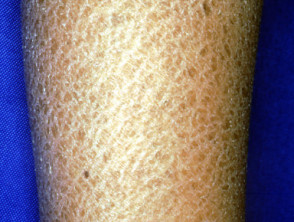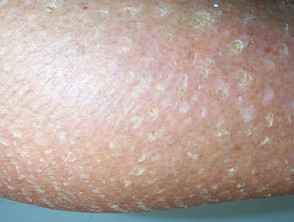What is dry skin?
Dry skin refers to skin that feels dry to touch. This occurs when the skin is lacking moisture in the outer horny cell layer (stratum corneum) and this results in cracks in the skin surface.
Dry skin is also called xerosis, xeroderma or asteatosis (lack of fat).
Who gets dry skin?
Both males and females of all ages can be affected. There is some racial variability in water and lipid content of the skin.
- Dry skin that starts in early childhood may be one of about 20 types of ichthyosis (fish-scale skin). There is often a family history of dry skin.
- Dryness is commonly seen in people with atopic dermatitis.
- Nearly everyone > 60 years has dry skin.
Dry skin that begins later may be seen in people with certain diseases and conditions, such as:
- Postmenopausal females
- Hypothyroidism
- Chronic renal disease
- Malnutrition and weight loss
- Subclinical dermatitis
- Treatment with certain drugs such as oral retinoids, diuretics and epidermal growth factor receptor inhibitors.
People exposed to a dry environment may experience dry skin, for example:
- Low humidity: in desert climates or cool, windy conditions
- Excessive air conditioning
- Direct heat from a fire or fan heater
- Excessive bathing
- Contact with soap, laundry detergents and solvents
- Inappropriate topical agents such as alcohol
- Frictional irritation from rough clothing or abrasives.
What causes dry skin?
Dry skin is due to abnormalities in the integrity of the barrier function of the stratum corneum, which is made up of corneocytes.
- There is an overall reduction in the lipids in the stratum corneum.
- The ratio of ceramides, cholesterol and free fatty acids may be normal or altered.
- There may be a reduction in the proliferation of keratinocytes.
- Keratinocyte subtypes change in affected skin with a decrease in keratins K1, K10 and increase in K5, K14.
- Involucrin (a protein) may be expressed early, increasing cell stiffness.
- The result is the retention of corneocytes and reduced water-holding capacity.
The inherited forms of ichthyosis are due to loss of function mutations in various genes (listed in parentheses below):
- Ichthyosis vulgaris (FLG)
- Recessive X-linked ichthyosis (STS)
- Autosomal recessive congenital ichthyosis (ABCA12, TGM1, ALOXE3)
- Keratinopathic ichthyoses (KRT1, KRT10, KRT2).
Acquired ichthyosis may be due to:
- Metabolic factors: thyroid deficiency
- Illness: lymphoma, internal malignancy, sarcoidosis, HIV infection
- Drugs: nicotinic acid, kava, protein kinase inhibitors (eg EGFR inhibitors), hydroxyurea.
What are the clinical features of dry skin?
Dry skin has a dull surface with a rough, scaly quality. The skin is less pliable and cracked. When dryness is severe, the skin may become inflamed and fissured.
Although any site can be dry, affected skin tends to involve the shins more than any other site.
The clinical features of ichthyosis depend on the specific type of ichthyosis.
Dry skin
Complications of dry skin
Dry areas of skin may become itchy, indicating a form of eczema/dermatitis has developed, such as:
- Atopic eczema — especially in people with ichthyosis vulgaris
- Eczema craquelé — especially in older people. Also called asteatotic eczema
- A dry form of nummular dermatitis/discoid eczema — especially in people that wash their skin excessively.
When the skin of an older person is dry and itchy without a visible rash, it is sometimes called winter itch, 7th age itch, senile pruritus or chronic pruritus of the elderly.
Other complications may include:
- Flaky skin or itchy skin (pruritus)
- Skin infection when bacteria or viruses penetrate a break in the skin surface
- Overheating, especially in some forms of ichthyosis
- Food allergy, eg, to peanuts, has been associated with filaggrin mutations
- Contact allergy, eg, to nickel, has also been correlated with barrier function defects.
How is the type of dry skin diagnosed?
The type of dry skin is diagnosed by careful history and examination.
In children:
- Family history
- Age of onset
- Appearance at birth, if known
- Distribution of dry skin
- Other features, eg eczema, abnormal nails, hair, dentition, sight, hearing.
In adults:
- Medical history
- Medications and topical preparations
- Bathing frequency and use of soap
- Evaluation of environmental factors that may contribute to dry skin.
Sometimes a skin biopsy may be requested. There may be additional tests requested to diagnose some types of ichthyosis.
What is the treatment for dry skin?
The mainstay of treatment of dry skin and ichthyosis is moisturisers/emollients. They should be applied liberally and often enough to:
- Reduce itch
- Improve the barrier function
- Prevent entry of irritants, bacteria
- Reduce transepidermal water loss.
When considering which emollient is most suitable, consider:
- Severity of the dryness
- Tolerance
- Personal preference
- Cost and availability.
Emollients generally work best if applied to damp skin, if pH is below 7 (acidic), and if containing humectants such as urea or propylene glycol.
Additional treatments include:
- Topical steroid if itchy or there is dermatitis — choose an emollient base
- Topical calcineurin inhibitors if topical steroids are unsuitable.
How can dry skin be prevented?
- Eliminate aggravating factors.
- Reduce the frequency of bathing.
- A humidifier in winter and air conditioner in summer.
- Compare having a short shower with a prolonged soak in a hot bath.
- Ensure good hydration by drinking plenty of water.
- Use lukewarm water, not hot water.
- Replace standard soap with a substitute such as a synthetic detergent cleanser, water-miscible emollient, bath oil, anti-pruritic tar oil, colloidal oatmeal etc.
- Apply an emollient liberally and often, particularly shortly after bathing, and when itchy. The drier the skin, the thicker this should be, especially on the hands.
What is the outlook for dry skin?
A tendency to dry skin may persist life-long, or it may improve once contributing factors are controlled.


